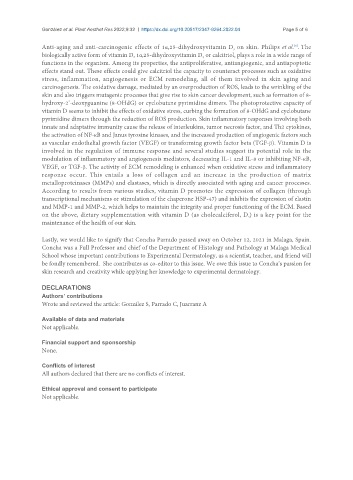Page 57 - Read Online
P. 57
González et al. Plast Aesthet Res 2022;9:32 https://dx.doi.org/10.20517/2347-9264.2022.04 Page 5 of 6
[6]
Anti-aging and anti-carcinogenic effects of 1α,25-dihydroxyvitamin D on skin. Philips et al. . The
3
biologically active form of vitamin D, 1α,25-dihydroxyvitamin D or calcitriol, plays a role in a wide range of
3
functions in the organism. Among its properties, the antiproliferative, antiangiogenic, and antiapoptotic
effects stand out. These effects could give calcitriol the capacity to counteract processes such as oxidative
stress, inflammation, angiogenesis or ECM remodeling, all of them involved in skin aging and
carcinogenesis. The oxidative damage, mediated by an overproduction of ROS, leads to the wrinkling of the
skin and also triggers mutagenic processes that give rise to skin cancer development, such as formation of 8-
hydroxy-2’-deoxyguanine (8-OHdG) or cyclobutane pyrimidine dimers. The photoprotective capacity of
vitamin D seems to inhibit the effects of oxidative stress, curbing the formation of 8-OHdG and cyclobutane
pyrimidine dimers through the reduction of ROS production. Skin inflammatory responses involving both
innate and adaptative immunity cause the release of interleukins, tumor necrosis factor, and Th2 cytokines,
the activation of NF-κB and Janus tyrosine kinases, and the increased production of angiogenic factors such
as vascular endothelial growth factor (VEGF) or transforming growth factor beta (TGF-β). Vitamin D is
involved in the regulation of immune response and several studies suggest its potential role in the
modulation of inflammatory and angiogenesis mediators, decreasing IL-1 and IL-8 or inhibiting NF-κB,
VEGF, or TGF-β. The activity of ECM remodeling is enhanced when oxidative stress and inflammatory
response occur. This entails a loss of collagen and an increase in the production of matrix
metalloproteinases (MMPs) and elastases, which is directly associated with aging and cancer processes.
According to results from various studies, vitamin D promotes the expression of collagen (through
transcriptional mechanisms or stimulation of the chaperone HSP-47) and inhibits the expression of elastin
and MMP-1 and MMP-2, which helps to maintain the integrity and proper functioning of the ECM. Based
on the above, dietary supplementation with vitamin D (as cholecalciferol, D ) is a key point for the
3
maintenance of the health of our skin.
Lastly, we would like to signify that Concha Parrado passed away on October 12, 2021 in Malaga, Spain.
Concha was a Full Professor and chief of the Department of Histology and Pathology at Malaga Medical
School whose important contributions to Experimental Dermatology, as a scientist, teacher, and friend will
be fondly remembered. She contributes as co-editor to this issue. We owe this issue to Concha’s passion for
skin research and creativity while applying her knowledge to experimental dermatology.
DECLARATIONS
Authors’ contributions
Wrote and reviewed the article: González S, Parrado C, Juarranz A
Available of data and materials
Not applicable.
Financial support and sponsorship
None.
Conflicts of interest
All authors declared that there are no conflicts of interest.
Ethical approval and consent to participate
Not applicable.

